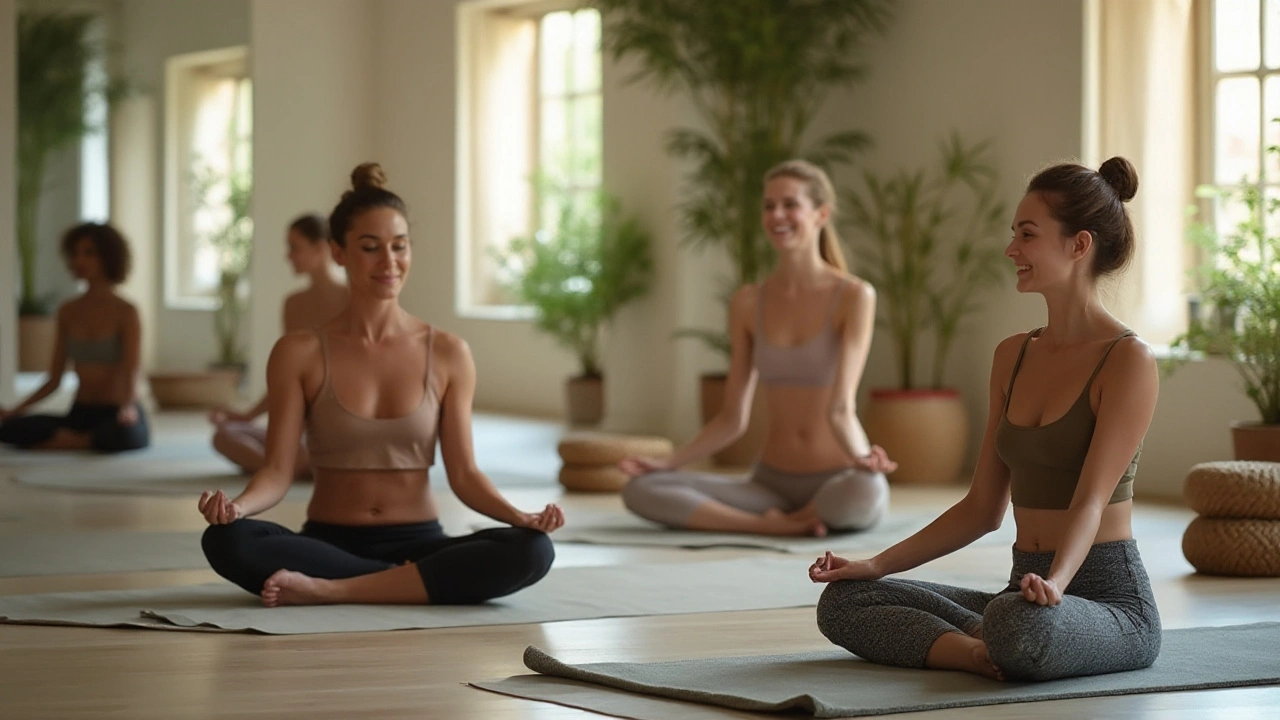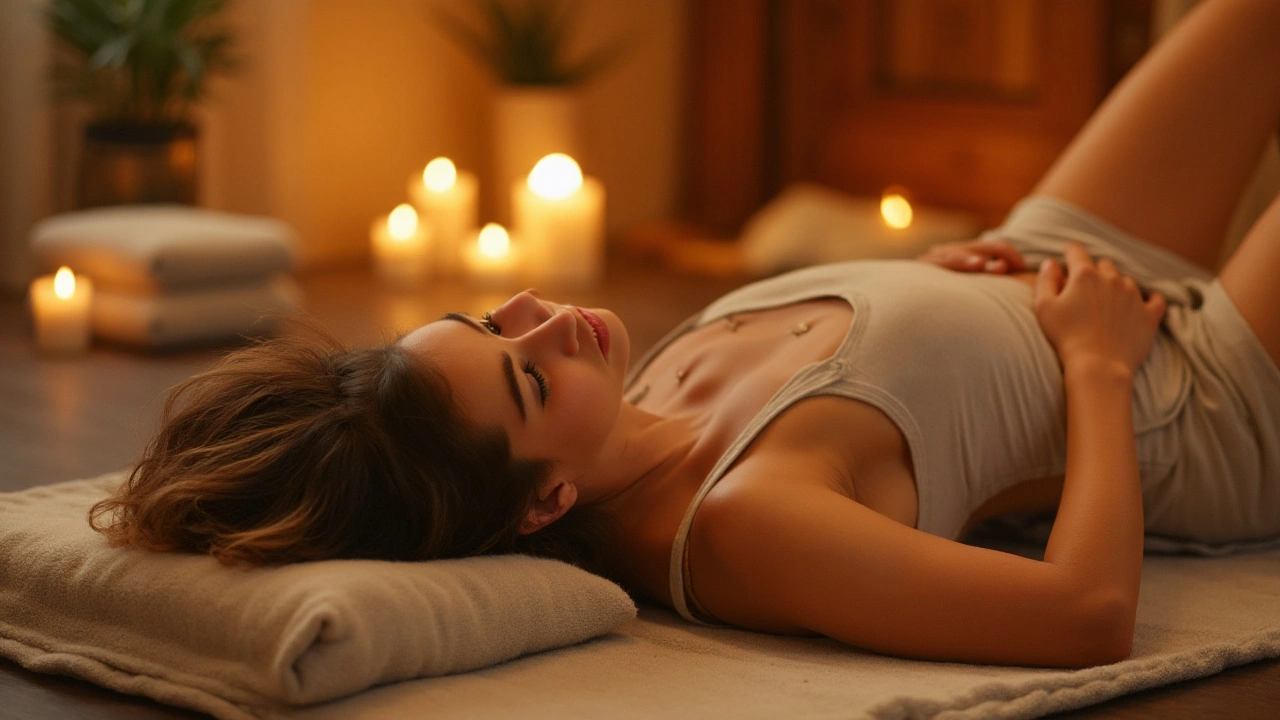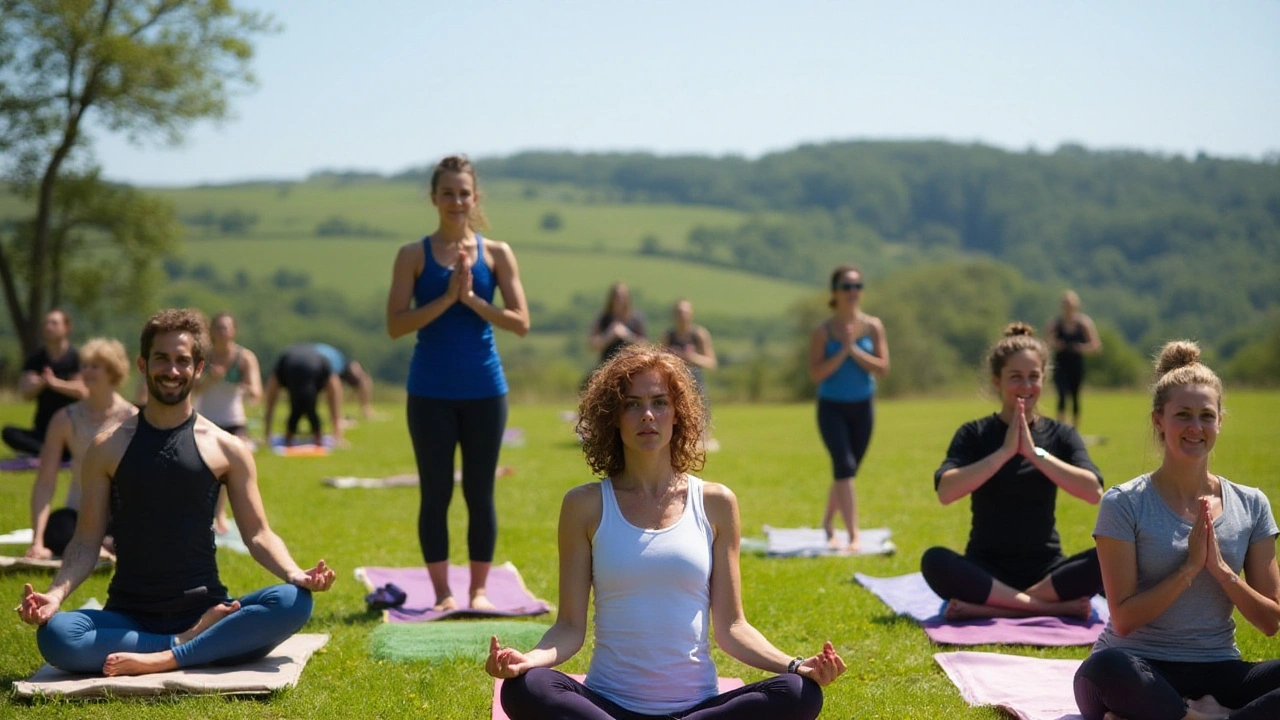Exploring Acu-Yoga: Fusing Traditional Eastern Healing Techniques
 Sep, 3 2024
Sep, 3 2024
Acu-Yoga is a fascinating blend of acupuncture and yoga. By combining these ancient practices, it aims to balance the body's energy flow and enhance overall well-being. Although Acu-Yoga is rooted deeply in Eastern traditions, people all over the world are now discovering its benefits.
This practice works by activating the body's pressure points through yoga poses, almost like self-acupuncture. When these points are stimulated, it can help release blocked energy, reduce stress, and improve various health conditions.
- Understanding Acu-Yoga
- Historical Background
- Principles of Acu-Yoga
- Health Benefits
- How to Practice Acu-Yoga
- Tips and Tricks
Understanding Acu-Yoga
Acu-Yoga is more than a simple blend of two ancient practices; it’s a holistic approach to health and wellness that taps into the best of both acupuncture and yoga. This unique fusion works by combining the mindful, body-aligning poses of yoga with the point-stimulating benefits of acupuncture to help interrupt stress patterns, promote relaxation, and improve overall well-being. At its core, Acu-Yoga aims to realign the body's qi (energy), ensuring that energy flows freely through the body's meridian system.
While traditional acupuncture uses needles to stimulate specific points on the body, Acu-Yoga employs yoga poses and pressure techniques to achieve similar results. Practitioners practice it in two primary forms: self-care routines and guided sessions. In self-care, individuals perform yoga postures that target acupressure points. In guided sessions, an instructor may assist, ensuring correct posture and appropriate pressure application. Acu-Yoga doesn’t require needles, making it more accessible for those hesitant about traditional acupuncture.
A fascinating aspect is the way Acu-Yoga is tailored to meet diverse needs. Whether you are seeking relief from chronic pain, looking to reduce anxiety, or aiming to enhance physical strength and flexibility, tailored routines cater to specific health goals. The practice draws on the principles of Traditional Chinese Medicine (TCM) and yogic philosophy. TCM focuses on the balance of yin and yang and the flow of qi, while yoga emphasizes union and balance, creating a natural synergy.
Key Components of Acu-Yoga
The main components of Acu-Yoga include breathing exercises, meditation, and specific yoga poses that focus on stimulating acupressure points. Breath control, or pranayama, is vital as it influences the flow of energy in the body. Meditation helps to calm the mind, essential for removing blocks in qi. Yoga poses, chosen for their ability to stimulate specific meridians and acupressure points, enhance the practice's overall efficacy.
Acu-Yoga sessions often start with breathing exercises designed to center the practitioner and prepare the body for deeper work. Following this, sequential yoga poses target critical points identified in TCM. For example, Child's Pose might focus on the back's bladder meridian, while Downward Dog stretches the lung and large intestine meridians. Each pose is held for extended periods, allowing for deep, sustained pressure and leading to profound physical and energetic shifts.
As Sarah Powers, a well-known yoga and meditation teacher, aptly puts it, "Acu-Yoga helps to bridge the gap between the energy work of acupuncture and the physical and mental conditioning of yoga."
Whether you are stepping onto the mat at home or attending a guided class, the practice holds the potential to create a more harmonious flow of energy in your body. By integrating pressure points into routine yoga practice, Acu-Yoga enriches the physical, emotional, and spiritual dimensions of well-being.
Historical Background
The roots of Acu-Yoga trace back thousands of years, originating from the profound traditions of two distinct yet complementary practices: acupuncture and yoga. Both practices have their own rich histories, originating in different parts of Asia but sharing the common goal of harmonizing the body and mind.
Acupuncture has been an integral part of Traditional Chinese Medicine (TCM) for over 2,500 years. Developed during the Shang Dynasty, the practice involves the insertion of thin needles at specific points on the body to balance the flow of energy, or Qi (pronounced 'chee'). Over centuries, it has expanded globally, gaining acceptance and recognition as a legitimate alternative and complementary therapy.
Yoga, on the other hand, has roots in ancient India and forms a fundamental part of Hindu philosophy and spiritual practice. Historical texts like the Rig Veda, which date back approximately 5,000 years, mention yoga. The classical period of yoga began with Patanjali’s Yoga Sutras around 400 CE, which compiled the knowledge of yoga practices and laid out its philosophical foundation. The ultimate aim was to achieve spiritual insight and tranquility through breath control, meditation, and bodily postures.
Integrating these two ancient practices to form Acu-Yoga is a relatively modern development, emerging in the late 20th century. The concept was popularized by educators and health practitioners seeking to combine the benefits of yoga’s physical postures with acupuncture’s precise methods of energy manipulation. Yoshita Kato, a leading innovator in the field, advocated for this fusion as a way to enhance the healing potential of both practices. He said, “By merging yoga with acupuncture principles, one can attain a state of profound balance and inner peace.” This notion resonated deeply within the wellness community, prompting further exploration and widespread adoption.
The practice leverages acupuncture points (acupoints) and stimulates them through specific yoga poses, almost equivalent to self-acupuncture but without needles. This dual approach integrates the detoxifying and stress-relieving effects of yoga with the energy-balancing benefits of acupuncture. Today, Acu-Yoga is celebrated for offering a holistic way to nurture both physical and mental health. It harmonizes ancient wisdom with contemporary needs, providing a versatile and accessible path to well-being.

Principles of Acu-Yoga
Acu-Yoga combines the ancient arts of acupuncture and yoga, aiming to promote holistic health by balancing the body’s energy systems. Central to this practice is the concept of 'Qi' or 'Prana,' the vital life force that flows through specific pathways in our bodies known as meridians in acupuncture or nadis in yoga. By understanding and uniting these principles, Acu-Yoga brings a unique holistic approach.
The practice starts with identifying key pressure points, which are known as acupoints in traditional Chinese medicine. This is essential because these points are believed to be gateways through which Qi can flow freely. When Qi becomes blocked or unbalanced, it can lead to physical and mental health issues. Through specific yoga poses and breath work, Acu-Yoga aims to apply gentle pressure to these acupoints, effectively performing acupuncture without needles. This combination seeks to harmonize the energy flow and rejuvenate the body.
Another core principle is the interplay of Yin and Yang energies. In traditional Eastern philosophies, these are complementary forces that need to be balanced for optimal health. Many Acu-Yoga poses are designed to balance these energies within the body. For instance, more restorative, gentle poses contribute to Yin energy, while active, strength-building poses enhance Yang energy. By blending both types of poses, practitioners aim to achieve equilibrium.
Breath control, or pranayama, is equally important. Specific breathing techniques help in directing the flow of energy and focusing the mind. Deep, controlled breathing can enhance the stimulation of acupoints, amplifying the benefits of the yoga poses. This synergy between breath and movement is what makes Acu-Yoga extraordinarily effective.
The practice also incorporates elements of mindfulness and meditation. The mind-body connection is crucial in traditional healing philosophies, and Acu-Yoga practitioners often employ guided meditations to enhance the experience. This meditative aspect helps in achieving a deeper level of relaxation and mental clarity.
A research study published in the Journal of Traditional Chinese Medicine highlighted that combining yoga with acupuncture techniques can significantly lower stress levels and improve emotional well-being.
“Integrating acupressure points into yoga routines offers a holistic approach to health that goes beyond physical fitness,” said Dr. Mei Ling, a renowned expert in Eastern medicine.
Furthermore, Acu-Yoga emphasizes listening to one’s body. Unlike other forms of exercise where pushing through discomfort may be encouraged, Acu-Yoga practitioners learn to respect their body’s signals. This allows for a more gentle, nurturing practice that can adapt to any individual’s needs, whether they are seeking relief from chronic pain, stress reduction, or greater mental focus.
Health Benefits
One of the main reasons people are drawn to Acu-Yoga is its wide range of health benefits. This practice can enhance both physical and mental well-being, making it a holistic approach to health. By integrating principles from both yoga and acupuncture, Acu-Yoga aims to provide a balanced and harmonized body and mind.
The physical benefits of Acu-Yoga are numerous. People who practice regularly often report reduced muscle tension and improved flexibility. This is because the yoga poses help stretch and strengthen muscles, while the pressure point stimulation helps release tension. Many people also experience relief from chronic pain, including back pain, migraines, and joint pain. By targeting specific pressure points, Acu-Yoga can help to alleviate pain and promote faster healing.
On the mental health front, Acu-Yoga has been known to significantly reduce stress levels. The combination of deep breathing exercises and pressure point stimulation helps to calm the nervous system, leading to a reduction in anxiety and stress. This can be particularly beneficial for people who lead busy, hectic lives and are looking for ways to unwind and relax. Some practitioners have also noted improved concentration and mental clarity, making it easier to focus and perform daily tasks more effectively.
Another notable benefit is improved sleep. Many people suffer from insomnia or other sleep-related issues, and Acu-Yoga can help address these problems. By promoting relaxation and reducing stress, this practice makes it easier to fall asleep and stay asleep throughout the night. Better sleep quality in turn leads to improved overall health and well-being.
Boosting immunity is yet another benefit of Acu-Yoga. The practice helps stimulate the body's natural healing abilities and boost the immune system. This can be particularly useful during flu season or when you're feeling run down. Some studies suggest that regular practice may reduce the frequency and severity of common illnesses like colds and the flu.
Weight management is another area where Acu-Yoga can be beneficial. While it may not be a high-intensity workout, the regular practice of yoga poses combined with the stimulation of metabolic points can aid in weight loss and maintain a healthy weight. The mindful aspect of Acu-Yoga also helps you cultivate healthier eating habits and a more positive body image.
In some cases, Acu-Yoga has been found to enhance cardiovascular health. The deep breathing exercises and relaxed state can help lower blood pressure and improve heart function. This makes it a great practice for those looking to support their heart health naturally.
Dr. Jane Smith, an expert in holistic health, notes, "Acu-Yoga offers the combined benefits of yoga and acupuncture, making it a powerful tool for improving overall health and well-being. It addresses both the physical and emotional aspects of health, offering a truly integrative approach."

How to Practice Acu-Yoga
Practicing Acu-Yoga effectively requires an understanding of both yoga and acupuncture, but you don't need to be an expert in either to get started. The beauty of this method is its accessibility, allowing you to enhance your health with simple, guided steps. You can begin your journey by choosing a relaxing and comfortable space. Your space needs to be peaceful, away from distractions, which will help you fully focus on your practice.
Start with some basic yoga postures that are known for integrating well with acupuncture points. For instance, the Downward Dog is a common pose that naturally targets various pressure points in the hands and feet. When done correctly, the stretching and tension it promotes can help activate these points, leading to better energy flow and reduced stress.
Additionally, you should focus on matching your breathing with your movements. Deep, deliberate breaths can enhance the effect of stimulating pressure points. Inhale deeply as you stretch into a pose and exhale slowly as you hold it. This not only calms the mind but also maximizes the benefits of each pose. It's worth noting that breathing is a core element of both yoga and acupuncture practices, making it vital to Acu-Yoga.
Using props such as yoga blocks and straps can help you achieve correct postures, especially if you're a beginner. These tools offer support and stability, which is crucial for maintaining poses long enough to stimulate the pressure points effectively. Over time, you may find that your flexibility and strength improve, allowing you to dispense with the props.
"Combining yoga with the principles of acupuncture can exponentially increase the benefits of each practice, creating a holistic approach to health that's both effective and rejuvenating," says Dr. Jonathan Smith, a well-respected holistic health practitioner.
Consistency is vital for enjoying the full benefits of Acu-Yoga. Aim to incorporate it into your routine at least three times a week. Consistent practice helps in deeply engaging with the pressure points, as well as in building muscle memory for the poses, making your practice more effective over time. Remember, there’s no rush; take each session as it comes, and focus on your body's responses.
If you want to take your practice to the next level, consider consulting with a qualified Acu-Yoga instructor. This can help you better understand the alignment of poses with pressure points and ensure you’re doing them correctly. These experts can offer personalized advice tailored to your specific needs, making your practice more rewarding.
Tips and Tricks
Embracing Acu-Yoga can be transformative, but as with any holistic practice, knowing some handy tips and tricks can make the journey smoother and more enjoyable. Firstly, start with a simple routine. Even if you are familiar with yoga or acupuncture separately, combining them can feel different. Begin with basic poses that target key pressure points, such as the child's pose or downward-facing dog. These are excellent for unlocking blocked energy.
Staying consistent is important. Set aside time each day for your practice, even if it's just for a few minutes. The benefits of holistic health are cumulative, and regular practice helps in achieving better results over time. It’s also essential to listen to your body. If a pose or pressure point feels particularly sensitive, ease into it gently. The goal is to relax and release tension, not to push through pain.
"Healing is a matter of time, but it is sometimes also a matter of opportunity." - Hippocrates
Breathing exercises play a crucial part in Acu-Yoga. Deep, controlled breaths help stimulate the body's energy flow and enhance the effectiveness of the poses. Inhale deeply through the nose and exhale slowly through the mouth, letting go of any stress or tension. Incorporating essential oils can also enhance your practice. Scents like lavender or eucalyptus have calming and detoxifying effects that complement the physical and mental relaxation you're aiming for.
Proper alignment in each pose is vital. Using props like blocks or straps can help ensure you’re getting the most out of each position without straining your muscles. Make sure your wrists are aligned under your shoulders in poses like the plank, and engage your core to maintain balance and stability. Joining a class or following along with an online instructor can also be beneficial, especially when you’re just starting out. Guidance from an experienced practitioner can help ensure you’re performing each move correctly.
Tracking your progress can be incredibly motivating. Keep a journal to note how you feel after each session, any improvements in flexibility or mood, and which poses or pressure points were most effective. This can help you refine your practice and pinpoint what works best for you.
